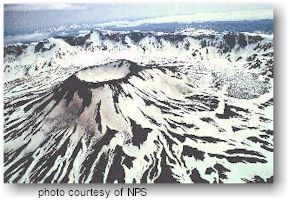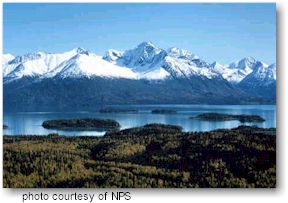


|

|
 Vent Mountain in Aniakchak National Monument |
 Lake Clark |
| Alagnak
Wild River - Alagnak Wild River is located in the
beautiful Aleutian Range. The river provides unparalleled opportunities
to experience the wilderness of the Alaska Peninsula.
Aleutian World War II National Historic Area - The Aleutian World War II National Historic Area encompasses the historic footprint of the U.S. Army base Fort Schwatka. Located on Amaknak Island in the Aleutian Island Chain of Alaska, the fort was one of four coastal defense posts built to protect Dutch Harbor (the back door to the United States) during World War II, the fort is also highest coastal battery ever constructed in the United States. Aniakchak National Monument and Preserve - The Aniakchak Caldera, is the result of a series of eruptions, the latest in 1911. Nearly six miles in diamerter and covering some ten square miles, it is one of the finest examples of dry caldera in the world. Located in the volcanically active Aleutian Mountains, the crater contains many outstanding examples of volcanic features, including lava flows, cinder cones, and explosion pits. Surprise Lake, located within the caldera, is the source of the Aniakchak River, which cascades through a 1,500-foot gash in the caldera wall. The site also contains the Aniakchak Wild River. Bering Land Bridge National Preserve - The Bering Land Bridge National Preserve is one of the most remote national park areas, located on the Seward Peninsula in northwest Alaska. The Preserve is a remnant of the land bridge that connected Asia with North America more than 13,000 years ago. The majority of this land bridge, once thousands of miles wide, now lies beneath the waters of the Chukchi and Bering Seas. Cape Krusenstern National Monument - Cape Krusenstern National Monument is a treeless coastal plain dotted with sizable lagoons and backed by gently rolling limestone hills. Cape Krusenstern's bluffs and its series of 114 beach ridges record the changing shorelines of the Chukchi Sea over thousands of years. Denali National Park and Preserve - It's more than a mountain. Denali National Park & Preserve features North America's highest mountain, 20,320-foot tall Mount McKinley. The Alaska Range also includes countless other spectacular mountains and many large glaciers. Denali's more than 6 million acres also encompass a complete sub-arctic eco-system with large mammals such as grizzly bears, wolves, Dall sheep, and moose. Gates of the Arctic National Park and Preserve - By establishing Gates of the Arctic National Park & Preserve (GAAR) in Alaska's Brooks Range, Congress has reserved a vast and essentially untouched area of superlative natural beauty and exceptional scientific value - a maze of glaciated valleys and gaunt, rugged mountains covered with boreal forest and arctic tundra vegetation, cut by wild rivers, and inhabited by far-ranging populations of caribou, Dall sheep, wolves, and bears (barren-ground grizzlies and black bears). Glacier Bay National Park and Preserve - The marine wilderness of Glacier Bay National Park and Preserve provides opportunities for adventure, a living laboratory for observing the ebb and flow of glaciers, and a chance to study life as it returns in the wake of retreating ice. Amidst majestic scenery, Glacier Bay offers us now, and for all time, a connection to a powerful and wild landscape. Inupiat Heritage Center National Historic Park - The Inupiat Heritage Center in Barrow, Alaska was designated an affiliated area of New Bedford Whaling National Historical Park in New Bedford, Massachusetts to ensure that the contributions of Alaska Natives to the history of whaling is recognized. More than 2000 whaling voyages from New Bedford sailed into arctic waters during the late nineteenth and early twentieth century. Many Alaska Natives, particularly Inupiat Eskimo people, participated in commercial whaling. In addition to crewing on the ships they hunted for food for the whalers, provided warm fur clothing, and sheltered many crews that were shipwrecked on the Alaska coast. Katmai National Park and Preserve - Katmai is famous for volcanoes, brown bears, fish, and rugged wilderness and is also the site of the Brooks River National Historic Landmark with North America's highest concentration of prehistoric human dwellings (about 900). |
Kenai
Fjords National Park - The Kenai Fjords reflect
scenic icebound landscapes in which salt spray mixes with mountain mist.
Located on the southeastern Kenai Peninsula, the national park is a
pristine and rugged land supporting many unaltered natural environments
and ecosystems.
Klondike Gold Rush National Historic Park - This park celebrates the Klondike Gold Rush of 1897-98 through 15 restored buildings within the Skagway Historic District. The park also administers the Chilkoot Trail and a small portion of the White Pass Trail. Included in the park is a portion of the Dyea Townsite at the foot of the Chilkoot Trail. Kobuk Valley National Park - Kobuk Valley National Park is encircled by the Baird and Waring mountain ranges. The park povides protection for several important geographic features, including the central portion of the Kobuk River, the 25-sqaure-mile Great Kobuk Sand Dunes, and the Little Kobuk and Hunt River dunes. Lake Clark National Park and Preserve - Lake Clark National Park and Preserve is a composite of ecosystems representative of many regions of Alaska. The spectacular scenery stretches from the shores of Cook Inlet, across the Chigmit Mountains, to the tundra covered hills of the western interior. The Chigmits, where the Alaska and Aleutian Ranges meet, are an awesome, jagged array of mountains and glaciers which include two active volcanoes, Mt. Redoubt and Mt. Iliamna. Lake Clark, 40 miles long, and many other lakes and rivers within the park are critical salmon habitat to the Bristol Bay salmon fishery, one of the largest sockeye salmon fishing grounds in the world. Numerous lake and river systems in the park and preserve offer excellent fishing and wildlife viewing. Noatak National Preserve - As one of North America's largest mountain-ringed river basins with an intact ecosystem, the Noatak River environs features some of the Artic's finest arrays of plants and animals. The river is classified as a national wild and scenic river, and offers surperlative wilderness float-trip opportunities - from deep in the Brooks Range to the tidewater of the Chukchi Sea. Sitka National Historic Site - Alaska's oldest federally designated park was established in 1910 to commemorate the 1804 Battle of Sitka. All that remains of this last major conflit between Europeans and Alaska Natives is the site of the Tlingit Fort and battlefield, located within this scenic 107 acre park in a temperate rain forest. Wrangell - St Elias National Park and Preserve - The Chugach, Wrangell, and St. Elias mountain ranges converge here in what is often referred to as the "mountain kingdom of North America." The largest unit of the National Park System and a day's drive east of Anchorage, the park-preserve includes the continent's largest assemblage of glaciers and the greatest collection of peaks above 16,000 feet. Mount St. Elias, at 18,008 feet, is the second highest peak in the United States. Adjacent to Canada's Kluane National Park, the site is characterized by remote mountains, valleys, wild rivers, and a variety of wildlife. Yukon - Charley Rivers National Preserve - Located along the Canadian border in central Alaska, the preserve protects 115 miles of the 1,800-mile Yukon River and the entire Charley River basin. Numerous rustic cabins and historic sites are reminders of the importance of the Yukon River during the 1898 gold rush. Paleontological and archeological sites here add much to our knowledge of the environment thousands of years ago. Peregrine falcons nest in the high bluffs overlooking the river, while the rolling hills that make up the preserve are home to an abundant array of wildlife. The Charley, a 100-mile long wild river, is considered by many to be the most spectacular river in Alaska.
|
|
|
|
For more information visit the National Park Service website |
|||